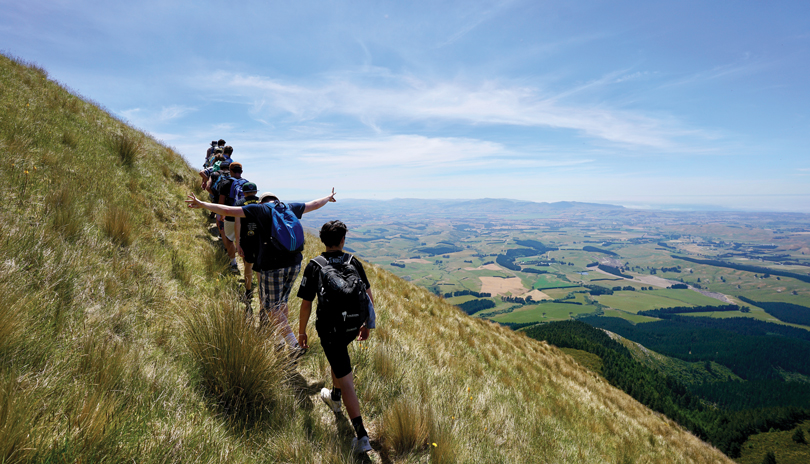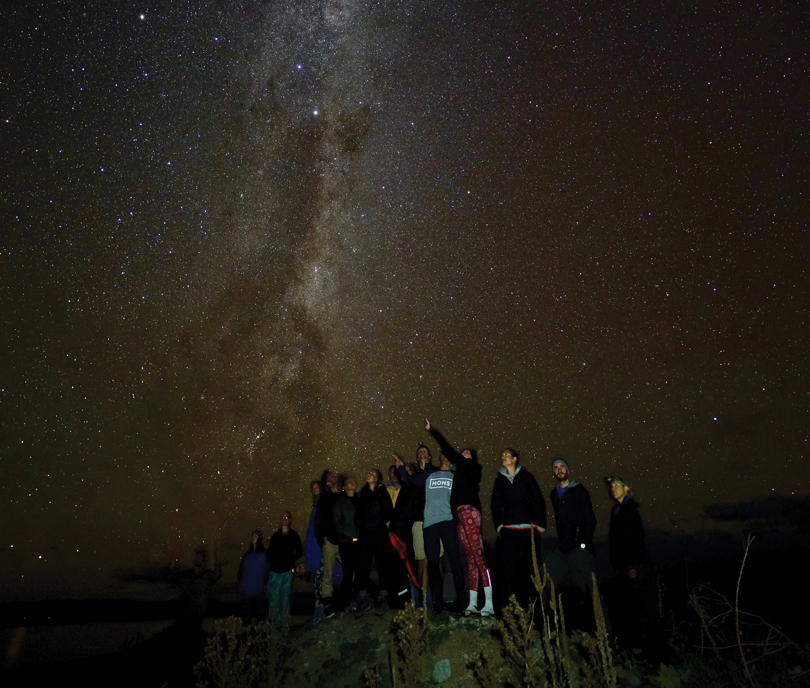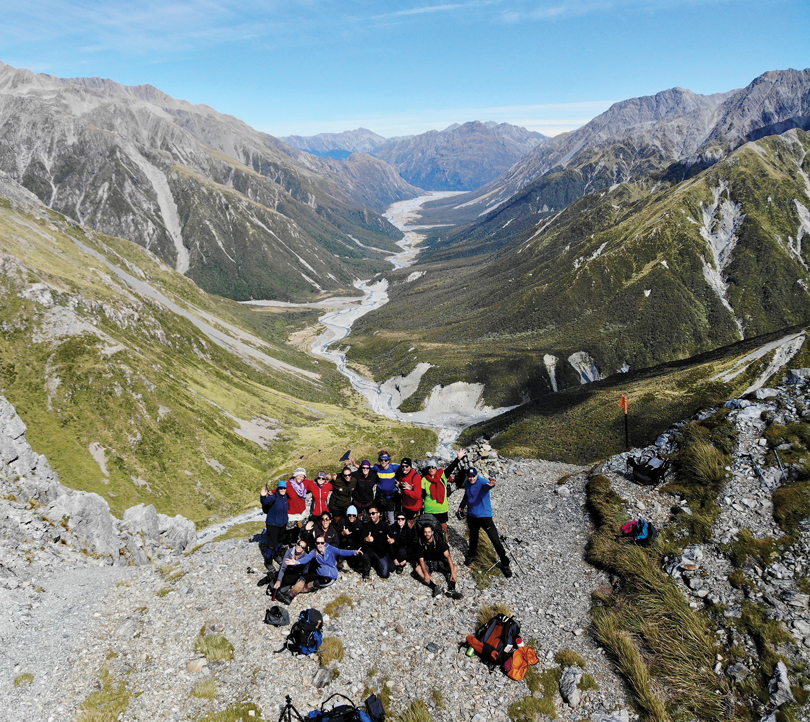Cultural Connection – a personal journey
Oct 3, 2018

More than 20 years has passed since settling Te Kerēme (The Ngāi Tahu Claim) – a milestone for Ngāi Tahu that propelled our iwi into a new era of economic and social prosperity. The generations of Ngāi Tahu who fought for Te Kerēme leave us with a legacy of hope, equipped with all the tools we need to build a strong and resilient network of hapū. In this article kaituhi Sampson Karst talks about his personal journey on two of our most established cultural development programmes: Manawa Hou and Aoraki Bound.

Above: Tamariki on Manawa Hou ki Tuahiwi get to climb the maunga tipuna of the takiwā, Maukatere.
Growing up in suburban Christchurch with my two siblings was a happy experience, albeit completely removed from our Ngāi Tahu heritage. Our father was adopted by a loving Pākehā whānau, while our maternal grandfather generally regarded Māori language and custom as regressive. Unfortunately these sentiments were passed down through the generations and our connection to Ngāti Irakehu and Ngāti Makō were nearly forgotten. When I was about 10-years-old, a nagging curiosity finally pushed my father to search for his biological parents and he uncovered his connection to Waikato Tainui. At the same time, he made an effort to rediscover our mother’s connection to Ngāi Tahu, and he promptly registered us with both iwi.
My journey of reconnection continued as a young adult when, after my first job in a kitchen joinery factory, I started work at the campus kōhanga reo at ARA (formerly CPIT). I treasured my time there. Being in an environment that celebrated te reo Māori and tikanga allowed me to explore my personal culture and heritage, although I quickly became aware that I needed to upskill. Having your language critiqued by four-year-olds is a humbling experience!
With the support of some amazing kaiako and compassionate classmates I completed a Diploma of Language and Indigenous Studies at Te Puna Wānaka, before following my passion for journalism and video production to the New Zealand Broadcasting School. In my first year I reached out to the Ngāi Tahu Fund. I was learning about storytelling techniques and was hungry for opportunities to explore my Ngāi Tahu heritage while putting my journalism skills into practice. The Ngāi Tahu Fund backed a video project that would document Ngāi Tahu people and projects throughout our takiwā, and the communications team at Te Rūnanga o Ngāi Tahu agreed to publish the content.
Aoraki Bound is a 20-day cultural and personal development programme. My hīkoi was everything I hoped it would be – a chance to immerse myself in my culture, walk in the footsteps of my ancestors, and gain a greater sense of my identity.
This project led to my first contact with Manawa Hou, a place-based learning wānanga run by Te Rūnanga o Ngāi Tahu, designed to help rangatahi learn more about their Ngāi Tahutanga. In 2013 I documented Manawa Hou ki Kaikōura.
It was an amazing hīkoi, including a trip outside of our takiwā to Kaihinu Pā, the first Ngāti Kurī settlement in Te Waipounamu, located in Kura Te Au (Tory Channel). We were fortunate to have Tā Tipene O’Regan on the boat ride with us out to the old pā site to deliver a summary of the hekenga (migration). It was in this moment that I realised the true power of the placed-based learning experience – it offers participants an intimate experience with our culture and history that can only materialise on the landscape. This crucial piece of insight motivated me to enrol in Aoraki Bound in 2014.
Aoraki Bound is a 20-day cultural and personal development programme. My hīkoi was everything I hoped it would be – a chance to immerse myself in my culture, walk in the footsteps of my ancestors, and gain a greater sense of my identity. The course culminates on the shores of Lake Pūkaki, in the presence of our Maunga Ariki, Aoraki. I parted ways with my rōpū, wiping tears of gratitude from my cheeks, knowing that my life had changed forever.

Above: Aoraki Bound participants standing on the edge of Lake Pūkaki turn their heads to the rising milky way to discuss the celestial origins of Te Waka o Aoraki.
I must have made an impression on our Ngāi Tahu facilitator, Tiaki Coates, because he asked me soon after if I would be interested in joining the Aoraki Bound delivery team. I jumped at the opportunity and learnt everything I could from outgoing kaiako Rangimārie Mules before joining Tiaki as a junior instructor.
I became further embedded in these development kaupapa in 2016, when Manawa Hou was held at my marae in Wairewa. I joined the tuākana rōpū to develop my facilitation skills and learn everything I could about the heritage that had been denied to generations of my whānau – and to provide that same opportunity to the rangatahi participating in each hīkoi.
Today, I am proud to be a tuākana on both Manawa Hou and Aoraki Bound. Working alongside fellow tuākana – Tiaki Coates, Ariana Stevens, and Donelle Manihera – we are now shaping each kaupapa to make sure they are fit-for-purpose.
Physical challenge is balanced with cultural challenge; that can vary from standing to recite a pepeha or taking the leap to stand on the paepae or perform your first karanga. The most important thing is that Manawa Hou and Aoraki Bound are safe and supportive environments to explore and participate in cultural practice.
To understand these programmes and to examine the greater question of their success, we need to understand how they evolved from a humble idea to connect our hapū and explore our takiwā. The Ngāi Tahu “bus tours” are often considered to be the first attempt at a place-based development programme, developed in response to the realisation that many young Ngāi Tahu had little understanding of the iwi. They would travel by bus to various marae to learn more about their cultural identity, a kaupapa that would evolve into Manawa Hou and Aoraki Bound.

Above: After tramping from sunrise to sunset over multiple days, Aoraki Bound participants pose for a photo on top of Nōti Raureka.
To date, Manawa Hou has been held in almost every corner of our takiwā, with the generosity and support of our Papatipu Rūnanga. When we visited Koukourarata we were bestowed with the greatest gift possible, when Peter Ramsden handed the mana of the marae to us. For the course of our wānanga, we were responsible for welcoming manuhiri to the marae on behalf of Ngāti Huikai. On Aoraki Bound, Ngāti Waewae impart knowledge of their greatest taonga, pounamu; and in Arowhenua the rōpū is given a guided tour of some of the most significant rock art sites.
Walking in the footsteps of our ancestors is an intimate and awe-inspiring way to explore the majesty of our takiwā and take in new vistas. Physical challenge is balanced with cultural challenge; that can vary from standing to recite a pepeha or taking the leap to stand on the paepae or perform your first karanga. The most important thing is that Manawa Hou and Aoraki Bound are safe and supportive environments to explore and participate in cultural practice.
I feel honoured to contribute to these two extraordinary kaupapa and look forward to the day my tamariki are old enough to participate. Titles like “instructor” or “tuākana” refer only to my responsibility to facilitate a learning environment, because some of the most profound cultural insights on Manawa Hou often come from our rangatahi. Highest amongst the privileges I have enjoyed during my time instructing has been the chance to put into action the dreams and aspirations of our tribal elders.